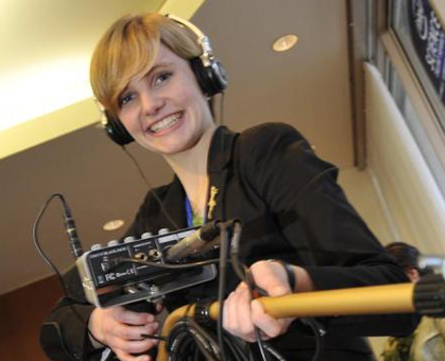WASHINGTON — Forty finalists from this year’s Intel Science Talent Search, the nation’s long-running precollege science competition, chatted up hundreds of visitors who dropped by the National Geographic Society on March 11 to learn more about the students’ research.


Vying for $630,000 in awards, the projects on display tackled real-world problems and contributed knowledge to fields ranging from mathematics to psychology.
Oliver Quintero of The Woodlands, Texas, for example, has created a new substance that promises to increase the voltage of lithium-ion batteries. “My goal is make a battery that can compete with fossil fuels,” said Quintero.
Personal experiences inspired many of the projects, which were picked from 1,839 entries to make it to this stage of the competition. Marian Bechtel of Lancaster, Penn., wants to develop a better way to detect land mines in part to protect her own family.
“I have cousins living in Mozambique who can’t step out the door without worrying about getting their legs blown off,” Bechtel said. She uses vibrations in the ground to ring mines like plucked banjo strings. Microphones mounted to a device that resembles a metal detector can hear this sound, revealing the locations of the mine husks Bechtel buried to test the device.
After getting to know some children with Down syndrome, Sayoni Saha of Cerritos, Calif., wanted to get inside their heads and gauge their self-esteem.
“I thought it was important for their voices to be heard,” said Saha. Her research showed that the kids prefer dolls that look like other children to dolls with features typical of Down syndrome. The modified dolls would “get teased,” some of the children said.
Zizi Yu of Woodbridge, Conn., spoke with concerned parents about her work on food and health. She studied whether infants exposed to shellfish, peanuts and milk are less likely to develop allergies to these foods later in life.
“Early exposure is beneficial,” Yu said to a mother whose child has food allergies.
To explain the sometimes complex science behind these projects, many students turned to their other interests and hobbies. Jordan Cotler of Northbrook, Ill., is a magician who has patented 27 magic tricks. Magic, he says, isn’t all that different from the weird quantum laws his project exploits to send encrypted messages.
“It’s like a coin trick,” Cotler told one onlooker, describing how quantum mechanics allows a particle to be in many places at once until observed. “I can have one coin in each hand, but I as soon as I open one hand and take a look, one of the coins disappears.”
The winners of the competition will be announced March 13 at a gala at the National Building Museum. Only one teen can take home the top award of $100,000 from the Intel Foundation, but all of the competitors have brought their passion for science to a very public stage.
“We say we’re looking for exceptional students who will become the future leaders in science, math and technology,” says Andrew Yeager, a physician at the University of Arizona College of Medicine who has been a judge for the competition for 27 years. “But I’d argue that these students are already leaders.”
The Intel Science Talent Search is a program of Society for Science & the Public, which publishes Science News.







